

THE USD VISTA
USD debuts new softball complex Stadium honors Reggie Smith and ushers
The University of San Diego has officially opened the Reggie Smith Softball Complex, a stateof-the-art facility that marks a new chapter for the Torero softball program and highlights the University’s growing investment in women’s athletics.
The stadium is named after Reggie Smith, a longtime member of the USD community.
For more than 50 years, Smith has supported student-athletes and helped build strong programs across the University.
Smith also helped start the Mulvaney Center, which connects students with local and global service work. Naming the stadium in her honor celebrates the impact she has had on campus and in the community.
The $14.5 million project was made possible by a generous gift from an anonymous donor.
USD Head Coach MJ Knighten, who has led the program for the past five years, explained how the facility represents more than just a playing surface — it symbolizes recognition and commitment.
“I think the girls deserve it,”
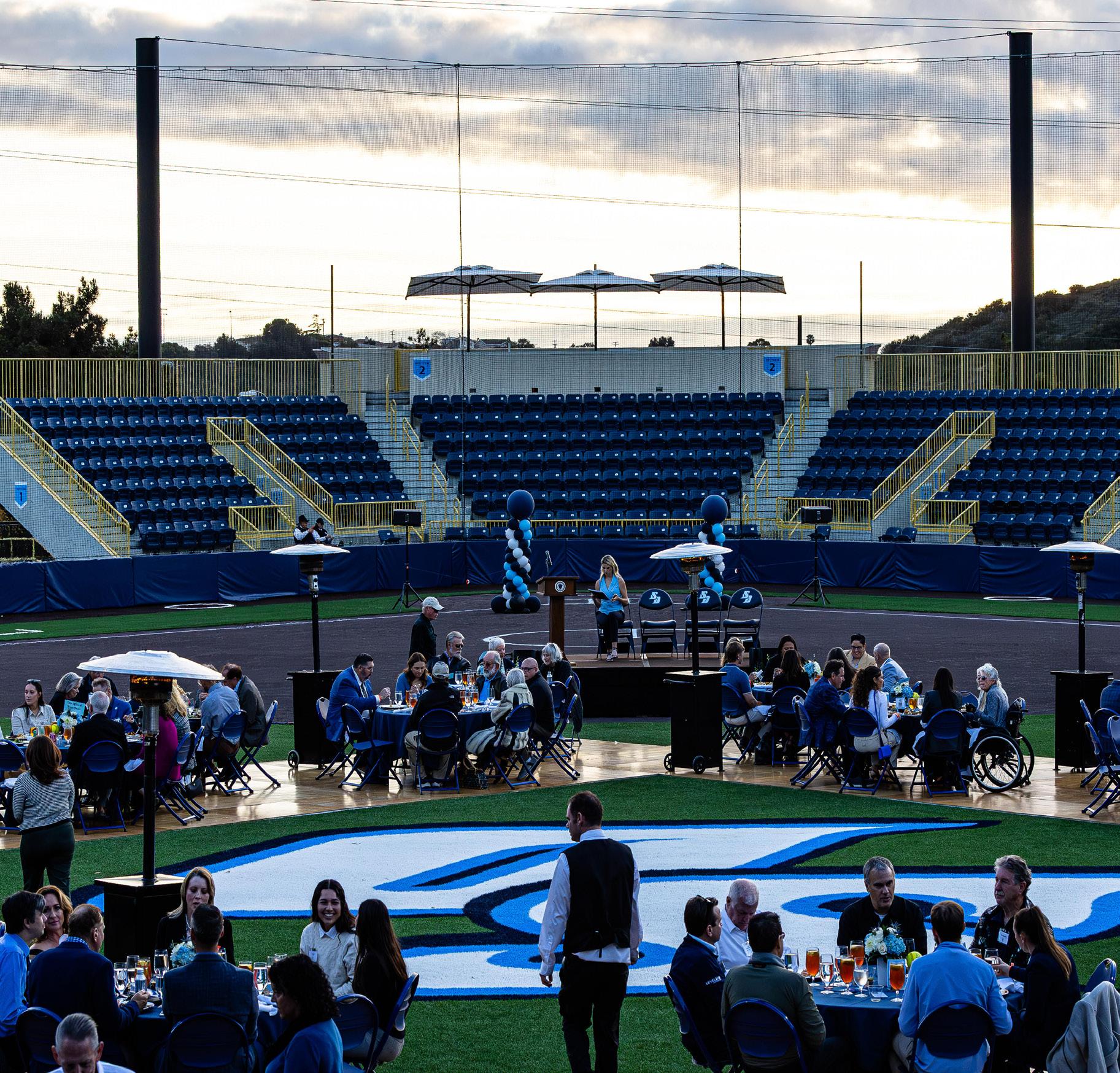
Knighten emphasized. “When you invest in women’s sports, it’s really going to show up for you as an athletic department and as a community. I think they feel that every single day now that they see the stadium.”
The complex includes a 4,500-square-foot team building with a locker room, sports medicine facility, equipment room, coaches’ offices and a lounge where players can study, eat and review game footage. The field itself features new dugouts and bullpens equipped with restrooms. A press box and expanded concourse with concessions and spectator bathrooms complete the experience for fans.
For USD Assistant Coach Shay Knighten, the new stadium goes beyond upgraded turf and new bleachers. She described the impact it’s had on the players, especially in how they see themselves and their place in the program.
“Their voices are being heard, they’re feeling seen and their hard work is actually paying off,” Knighten expressed. “It’s really cool that we finally get a home to call our own.” Knighten emphasized
This semester, USD Dining has hosted multiple culturallyinspired food events in the Student Life Pavilion (SLP). At the events, they serve various dishes at the food stations, bring in live bands, play music on speakers and decorate the cafeteria in order to reflect the theme of each event.
Celebrations for the Lunar New Year, Black History Month, Holi and a night for New York have all been held in the SLP. Toreros, specifically underclassmen, flocked to each of these events, forming lines reaching as far back as the SLP entrance to feast on the dishes written in the menus shared through email and on Instagram before each night.
USD Dining’s decision to dive into the vast intricacies of representing a culture’s food through various dishes has
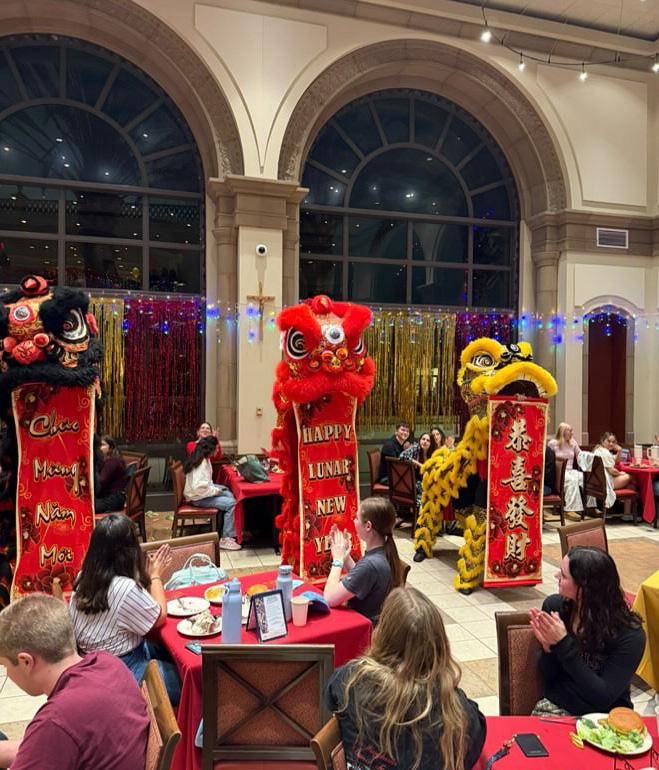


The ribbon cutting event occurred last Thursday and honored Reggie Smith.
Photo courtesy of Tom Christensen
CHERISHANN DIAMZON CONTRIBUTOR
Pope Francis recovers from illness
Bishop of Rome discharged from 5 week hospital stay
The pope is now in better condition after a long stint in a Roman hospital.
Pope Francis was elected to succeed Pope Benedict XVI in 2013 and has been recognized for his humility and informality compared to previous popes. He has made progressive changes by allowing women to be full members of departments within the Vatican, in addition to expressing sympathy toward members of the LGBTQ+ community. The pope has also focused a large amount of his papacy on climate change and has negotiated diplomatic relations between countries.
In March, the pope was admitted to a hospital in Rome with a respiratory tract infection that had caused pneumonia in his lungs. During the 38-day stay, other complications arose, including multiple respiratory crises and mild kidney failure. The pope’s personal aides, nurses and hospital staff feared that the end may be in sight for the Bishop of Rome. However, this past week, Pope Francis was discharged from the hospital by his doctors, but urged to rest. After making a brief public appearance, wellwishers could see the extent as to what the pope had faced in the hospital. Those who saw the pope in the flesh could see the visible decline and noted that his voice was weak, almost inaudible.
“I thank you from the bottom of my heart for your prayers for my health from the Square, I accompany you from here,” the pope stated, short of breath, in an audio message to the public. “May God bless you and the Virgin protect you. Thank you.”
Many people around the world, including USD students, stood in uncertainty as the pope’s health journey wavered. USD sophomore Lily Delahanty weighed in on the pope’s critical condition.
“He really needs to step down, he said he would,” Delahanty stated. “I really do love him though.”
The pope has previously stated that he believes the role of the papacy is a role for life, and has often ruled out or denied
any allegations that he would step down. However, after his election he signed a letter of resignation in the case that a health issue prevented him from carrying out his duties.
Not only has the pope made strides in politics and activism, but he also serves as a nostalgic and fatherly figure in the Catholic Church. Many remember where they were when the pope assumed the papacy.
“I remember the day he became the pope,” Delahanty commented. “I was in third grade and went to Catholic elementary school, so it was a really big deal. My crush hugged me. I will never forget it.”
Others look up to the pope and see him as an influential figure in the Catholic Church. Grant Chucri, a USD sophomore, looks to the pope as a symbol of comfort.
“I have a spiritual connection to the pope,” Chucri stated. “I am rejoicing that he is doing better. He kind of feels like my grandpa in a way.”
The pope’s doctors recommended that he take a two-month recovery period wherein he will be making less appearances. The pope has returned to the Apostolic Palace, his home within the Vatican. He will remain on oxygen and has been instructed to stay away from large groups of people. Doctors also noted that as the Catholic leader’s condition improved in the hospital, his sense of humor and dignity returned as well.
Though some students had not heard the news about the pope, they still worry about how his health may improve or decline. USD sophomore Katelyn Linaugh was unaware of the pope’s condition.
“I don’t even know what was wrong with him, but good for him that he’s doing better,” Linaugh added.
This time of uncertainty has also had many people questioning who the next pope would be. Though no successor has been chosen, there are many Catholic magistrates from around the world who are being considered.
In order to be elected as the next pope, eligible cardinals will participate in a secret ballot in the Sistine Chapel. Cardinals must be under 80 years of age to be considered eligible to be an elector.
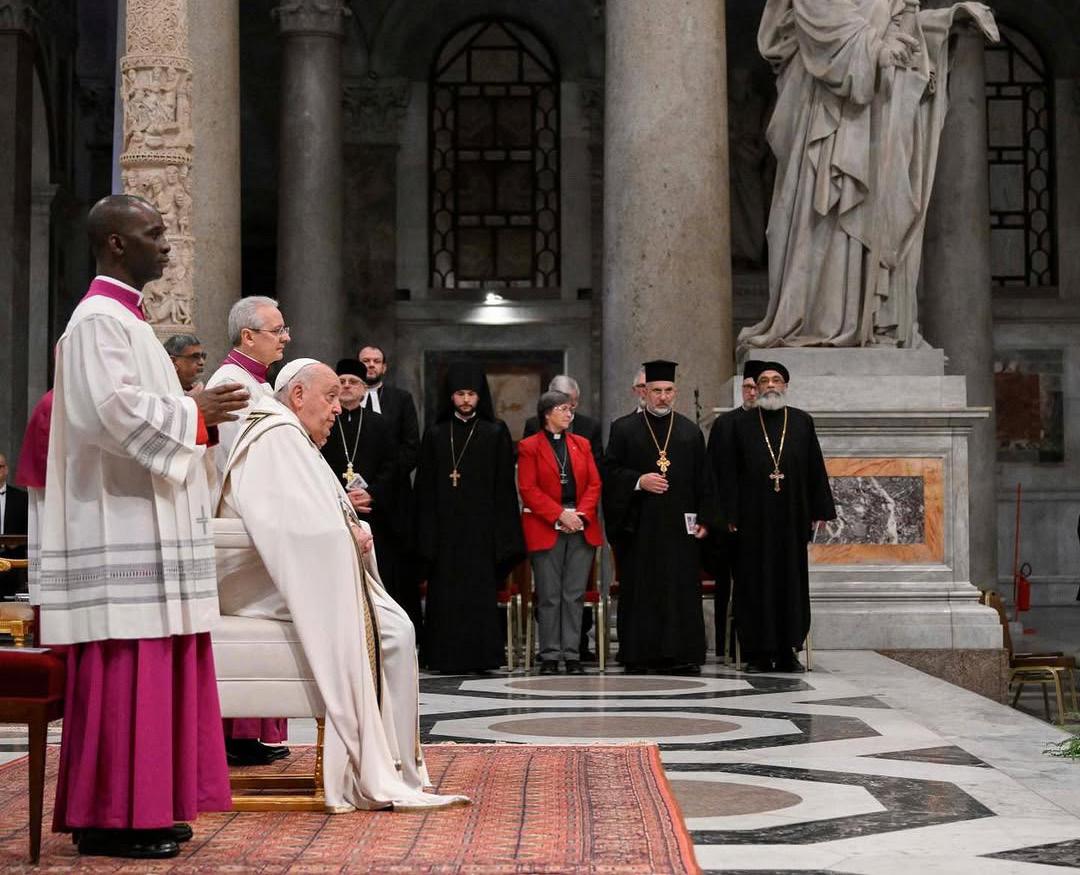
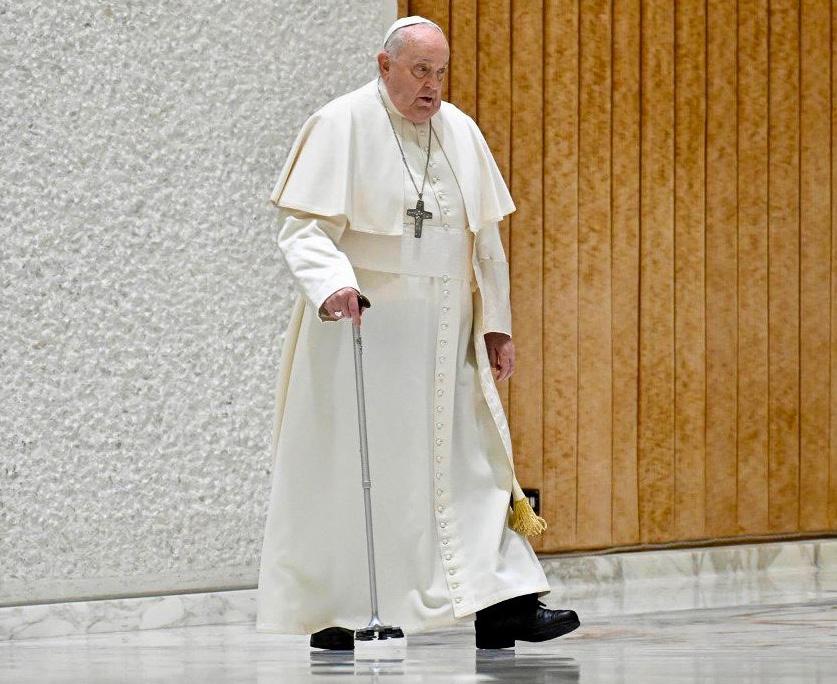
Elections typically last between 15 to 20 days as four rounds of voting take place. A candidate is elected once they have received two-thirds of the majority vote.
Some of the options for those who may be considered include 70-year-old Cardinal Pietro Parolin. Currently, Parolin is the highest-ranking cardinal and he has been the Vatican’s secretary
of state since 2013. Another candidate for the papacy is Cardinal Peter Erdo of Hungary. Erdo is known for being rather conservative and has been outspoken in his opposition to divorced and remarried Catholics having the ability to receive the Eucharist. Cardinal Luis Antonio Tagle of the Philippines is also a front-runner for the role. Tagle
would be the first Asian pope in the Catholic Church, and his politics have been described as left-leaning. Tagle has criticized the church on its attitude towards the LGBTQ+ community and unwed mothers. As the pope’s health remains uncertain, Catholics await the news as to whether or not the pope will step down as well as how his condition will continue to change.
Quinn Hallinan - Advertising Manager
Gina Lew - Student Media Advisor
Marie Minnick - Operations Advisor
MAE O’MALLEY ASST. NEWS EDITOR
The pope is known for his kindness and open-mindedness compared to other popes.
Photo courtesy of @franciscus/Instagram
The pope has returned to the Vatican.
Photo courtesy of @franciscus/Instagram
USD admits the Class of 2029 University sends decisions to prospective students
EMMA PIRHALA NEWS EDITOR
Throughout March, USD released admissions decisions to applicants hoping to join the Class of 2029. The University’s popularity has been on the rise in recent years, with the number of applicants increasing from 13,287 in 2018 to 17,010 in 2024. Despite the higher number, class sizes have remained relatively stable, with around 1,100 students enrolled yearly. For the incoming class, USD’s goal is to enroll 1,350 first-year students for the Fall 2025 semester. If the University achieves this goal, then the class would be the largest ever enrolled at USD.
This year, USD accepted 8,801 students, just a hundred less than the previous year. The group’s academic profile is similar to that of previous classes. The average weighted GPA of
accepted students was 4.14, higher than last year’s applicant pool. Beyond academics, the admits have diverse backgrounds with 56% attending public high schools and 21% being the first in their family to attend college.
USD junior Mary Kissinger shared her perspective on the academic profile of applicants.
“4.14 is pretty high,” Kissinger shared. “It’s cool to see that we are attracting more students, and maybe this will lead to more competitive academics.”
Some USD students are concerned that enrolling a larger class could create a burden for existing students.
In recent years, housing has been limited. This has led to single rooms being converted into doubles and some students moving off-campus after being denied on-campus housing.
USD sophomore Alexa Kreider shared her experience with lack of housing due to large classes.
“In my freshman year it felt really crowded,” Kreider said. “I was in Maher, and I had three roommates. I was in a quad. Obviously there’s limited housing because this freshman class is probably as big as my freshman class, maybe even bigger.”
As the University has expanded, on-campus parking has become limited. Kreider explained how difficulties with parking impact her.
“Walking around campus, it’s fun to see all the students and all the cars,” Kreider said. “But there is an overflow of cars and you can never really find parking. [Increasing enrollment] is definitely a challenge with just how small our physical spaces are.”
Despite concerns, USD Director of Admissions MinhHa Hoang ensured that enrollment is carefully planned and takes many factors into account — including housing.
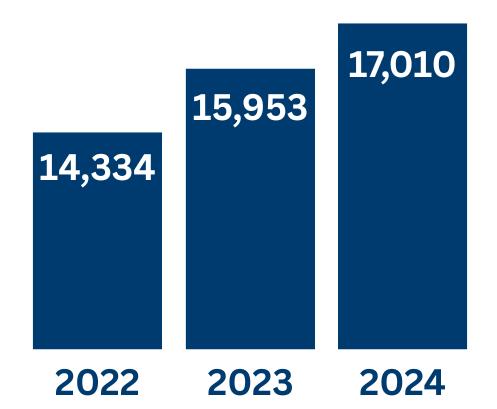
“Enrollment planning happens long before the class is actually selected,” Hoang said.
“Decisions on the size of the class are made after conversations with senior leadership, student affairs and housing, the Deans and many others on campus.”
As the University prepares to welcome what
Crossword of the week: April Fools’ edition GAMES

JACKIE MARQUEZ EDITOR-IN-CHIEF
Across
could possibly be its largest incoming class, questions remain regarding housing and class sizes. Statistics regarding the enrolled class will not be available until the fall. However, administrators continue to emphasize the critical planning that goes into increasing enrollment.
2. Synonym for goofy
7. Mischevious behavior
8. What you play on someone early in April
10. The fifth month of the year
12. Knock knock _______
13. Someone who is easily tricked
Down
1. When you pull off the perfect practical joke you may feel ______.
3. What you might pull on April 1
4. You may get up to _____ on April Fools’ Day.
5. What someone might say if you fall for their prank
6. You might replace sugar with this as a prank.
7. Many pranks come as a ______.
9. This cushion imitates the sound of flatulence.
11. What you do when you hear a joke
Total applicants for the Fall semester is continuously on the rise.
Emma Pirhala/The USD Vista
ARTS & CULTURE
SLP serves up cultural nights
Toreros discuss representation at dining events
From SLP, Page 1 sparked some backlash among USD students.
USD Auxiliary Services is the department at USD that provides additional supportive operations to the school, including cafeteria services. They explained the goals behind these dinner events and how they see them aligning with the school’s mission.
“Many of the special event dinners are in alignment with the university, its core values and goals — for example; USD is a border university, has a partnership with the National Hispanic Institute and San Diego is famous for its vibrant and delicious Latin cuisine,” Auxiliary Services said. “USD Dining strives to celebrate these unique attributes of our campus and city through the food and events we prepare for our students.”
When USD first-year, Ryan Pennington attended the dinner dedicated to Holi, a Hindu festival primarily celebrated in India and Nepal, he did not think the food lived up to his standard of authentic Indian cuisine.
“The tikka masala specifically was not as authentic as what I have had in the past,” Pennington explained. “I would say it’s because Indian food relies on spices and those foods did not have any. Whenever the menu gets released, you’re like, ‘Whoa, this actually looks fire.’ But when you try it, it doesn’t live up to your own standards because you’ve had it before.”
The ways in which USD Dining has incorporated music and decorations have also been brought up by students. USD first-year Kanye Johnson gave his opinion on the music at these cultural events.
“I want to know who’s controlling aux, because I don’t think a lot of the music is politically correct,” Johnson explained.
As hungry dinner-goers flock to the cafeteria on these special nights, searching for their most anticipated dishes from the menu at each station, some students wonder about the intentions behind these events.
Anna Pollon, a junior at USD, explained her take on the cultural food nights.
“While I appreciate SLP trying to expand people’s pallets for cultural food, oftentimes it is done in a tasteless way,” Pollon explained. “I think instead of making a big show of one culture’s cuisine, they could just incorporate it into a station that rotates weekly. It’s nice that they’re changing it up though.”
Kyra Lefebvre, a USD first-
year who frequents these events, also speculated about the message these nights convey.
“When you group those cultural nights into the rotation with arbitrary nights, it makes me question whether the school sees those groups as a culture to celebrate or just a theme,” Lefebvre said.
Not all students have been critical of USD Dining’s efforts to celebrate through these events. Lefebvre acknowledged Dining Services’ efforts to celebrate USD students with her outlook on these cultural celebrations.
“I certainly appreciate the effort,” Lefebvre said. “I definitely see what the school is trying to do in uplifting underrepresented groups and cultures.”
While Dining Services has held nights representing some different cultures, there are still some that they have not celebrated yet this school year. Ellie Baker, a USD firstyear student, wishes that Dining would continue to branch out with their events.
“I would love it if they had a Mexican culture night,” Baker stated. “It would be really nice to see my culture represented.”
During the Lunar New Year celebration, the SLP served Asian cuisine and invited people to perform a Chinese dragon dance around the dining pavilion.
Camryn Adams, a USD firstyear and active member of the Filipino Ugnayan Student Organization, expressed her opinion on this night.
“I think it was a fun way to learn about Chinese culture,” Adams stated. “They definitely did their best with the resources that they had.”
USD Dining has also held multiple other specific food nights at the SLP, including breakfast for dinner and a wing night. These nights have had event-specific menus that change the dishes at each food station, aimed at providing a short departure from the traditional cafeteria food that many USD students eat every night.
Dining services has also hosted multiple holiday celebrations this school year, including Thanksgiving and Christmas dinners with menus containing traditional holiday dishes for each night.
Pennington expressed his appreciation for these holiday nights.
“I like that they do the holiday dinners because there are a lot of people who don’t get to celebrate,” Pennington said. “It’s fun to see everyone celebrate like a family would.”
As these SLP events have
raised doubts of authenticity and accurate representation, USD Dining has given students the opportunity to submit feedback. USD Auxiliary Services shared how students can submit feedback and where to find it.
“We provide a survey for students after every special event at Pavilion Dining and welcome student feedback on themes, menus, entertainment and more,” Auxiliary Services said. “The survey is advertised at the
dinners and also promoted via mass emails to all students.”
As these nights have continued, some students have thought up possible solutions for the next time USD Dining holds a cultural event. Johnson provided a suggestion for USD Dining to incorporate on their next themed night.
“Maybe instead of introducing a large selection, they should focus on one dish that they want to specialize in,” Johnson suggested. “I just don’t think whatever is happening right now is working for everyone.”
USD Dining has announced upcoming events such as the Strawberry Festival on April 10. They also plan to hold a Plant Forward Night, an Easter Dinner, a Country Fair and another Breakfast at Dinner event. These events will take place through April and May. As some students simply appreciate a change in the menu, other USD students question the representation provided by these events.
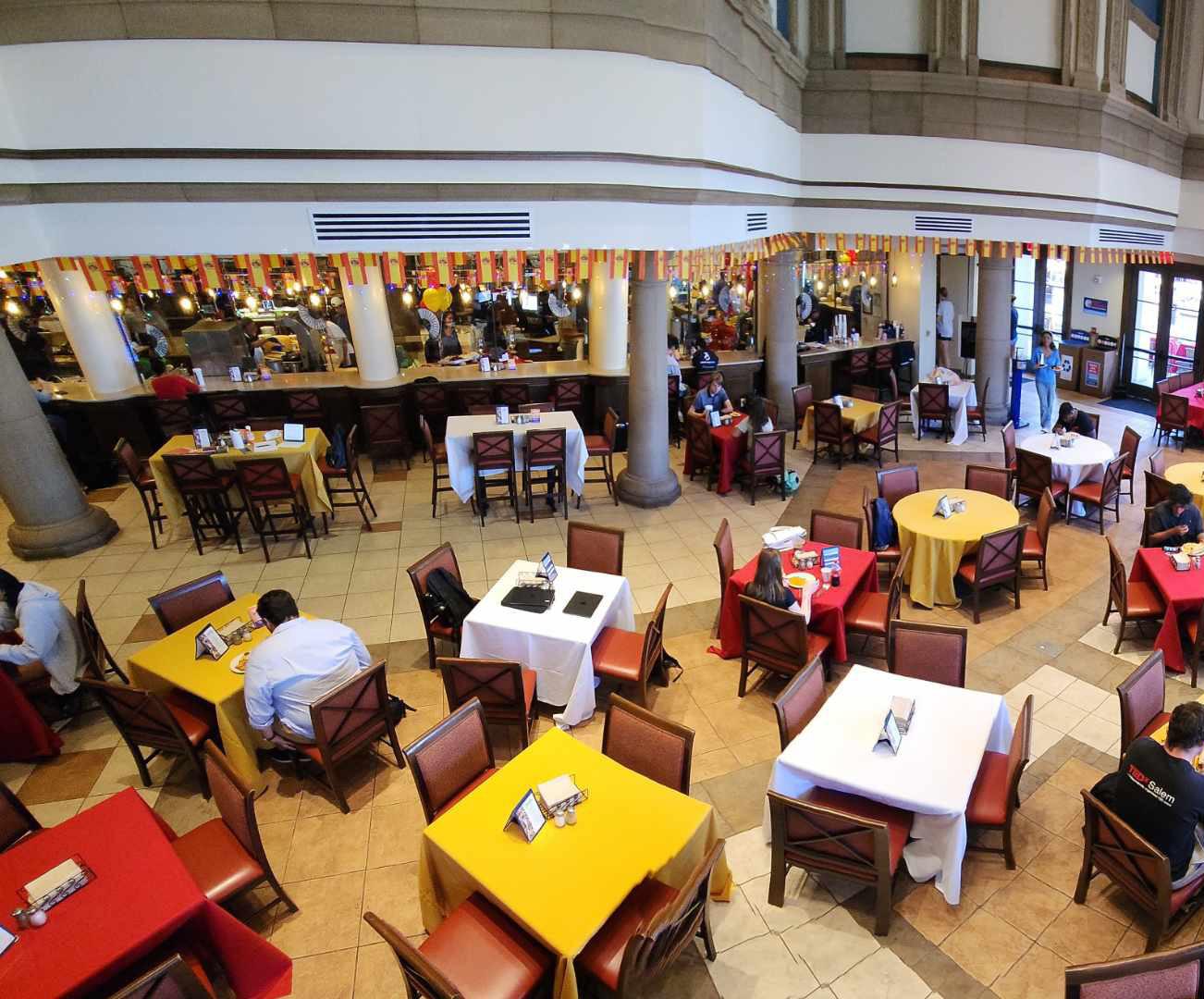

SLP’s Holi dinner featured chicken tikka masala along with other traditional dishes.
Photo courtesy
USD Dining frequently hosts themed cultural nights at the Student Life Pavilion.
Photo courtesy of Auxiliary Services at USD/Flickr
Lost in Lumon
Apple TV+’s ‘Severance’ season finale leaves fans in suspense
RILEY RAINS SPORTS EDITOR
“Severance,” the Apple TV+ series starring Adam Scott, released its final episode of season two on March 21, leaving fans distraught. The series surrounds a corporation, Lumon, whose employees have agreed to “sever” their memory — splitting their consciousness between work-life and home-life.
The Emmy-winning psychological thriller challenges a variety of political and social understandings. The show is so controversial that it has caused debate in major news sources such as The New York Times, The New Yorker and USA Today about work and home life, racism and child labor. Influencers and bloggers are eager to share conspiracy theories related to the complex plot, but no one knows as much about the series as the screenwriter himself, Dan Erickson.
Erickson is an American television screenwriter, showrunner and producer. He graduated from the New York University’s Tisch School of the Arts with a Master of Fine Arts in dramatic writing for television. In an interview with Script, an American magazine, about “Severance,” Erickson shared how the concept of the show first came to him.
“The idea first occurred to me not as a TV show, but as something that I would actually like to do to my own brain,” Erickson explained. “I was literally walking into work one day at a job I really hated and caught myself thinking, ‘What if there was some way to just dissociate, and for my body to do whatever it needs to do over
the next eight hours to earn this paycheck — to not have to consciously experience it?’”
Erickson and his team, including Ben Stiller, the executive producer and director of “Severance,” took the idea and ran with it.
“When Ben got involved, we worked to hone [the plot] down to the more grounded, still very strange, and very askew, but slightly more human-focused version that it is today,” Erickson said.
The plot follows Mark Scout, an employee at Lumon Industries played by Scott, after undergoing the surgical procedure known as “severance.” Scout and his coworkers work to uncover the corporation’s secrets, all while living in the mystery of their “outie’s” personal lives. “Outies” and “innies” are terms referring to characters’ “inner” work lives, and “outer” home lives.
The series plays with a variety of eerie cinematic strategies, something that Sara Hasselbach, the USD Writing Center director, especially noticed with her literary expertise.
“Something so arresting is the atmosphere it creates,” Hasselbach said. “We’re so conditioned, in season one and beyond, to be used to that sterile office, that when we get outside of it, that starts feeling unnatural. Nature being unnatural is seriously unsettling.”
The uncanny mood that “Severance” creates was done purposefully as a way to reflect modern day institutions.
“One thing that we talked about a lot was that you’re never really outside of Lumon, like you can go outside of the building, but their tentacles are still everywhere,” Erickson said.
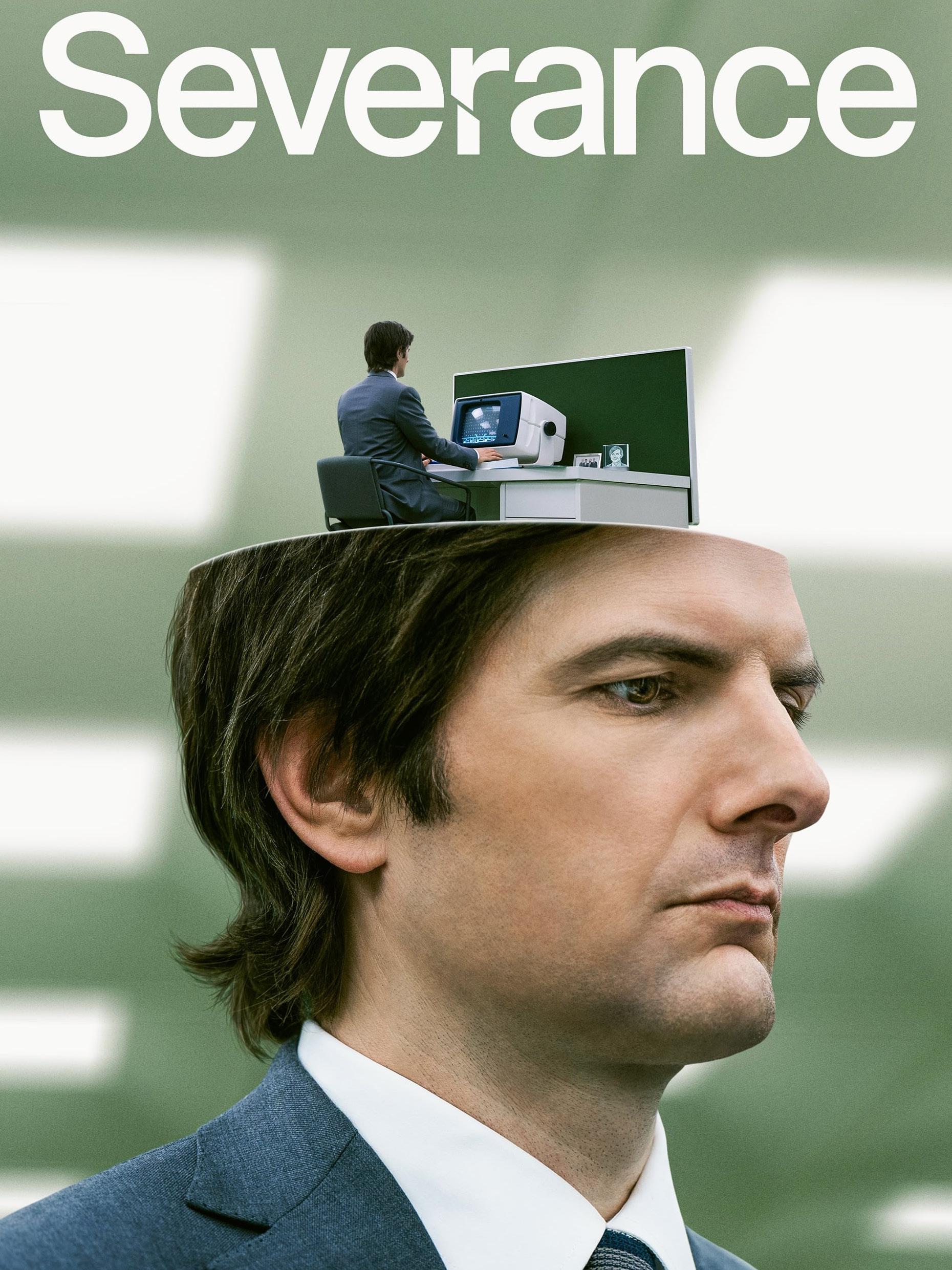
“It’s in the same way that a lot of corporations or institutions will insinuate themselves into culture in a way that’s not often obvious … We tried to have this sort of creeping sense of dread
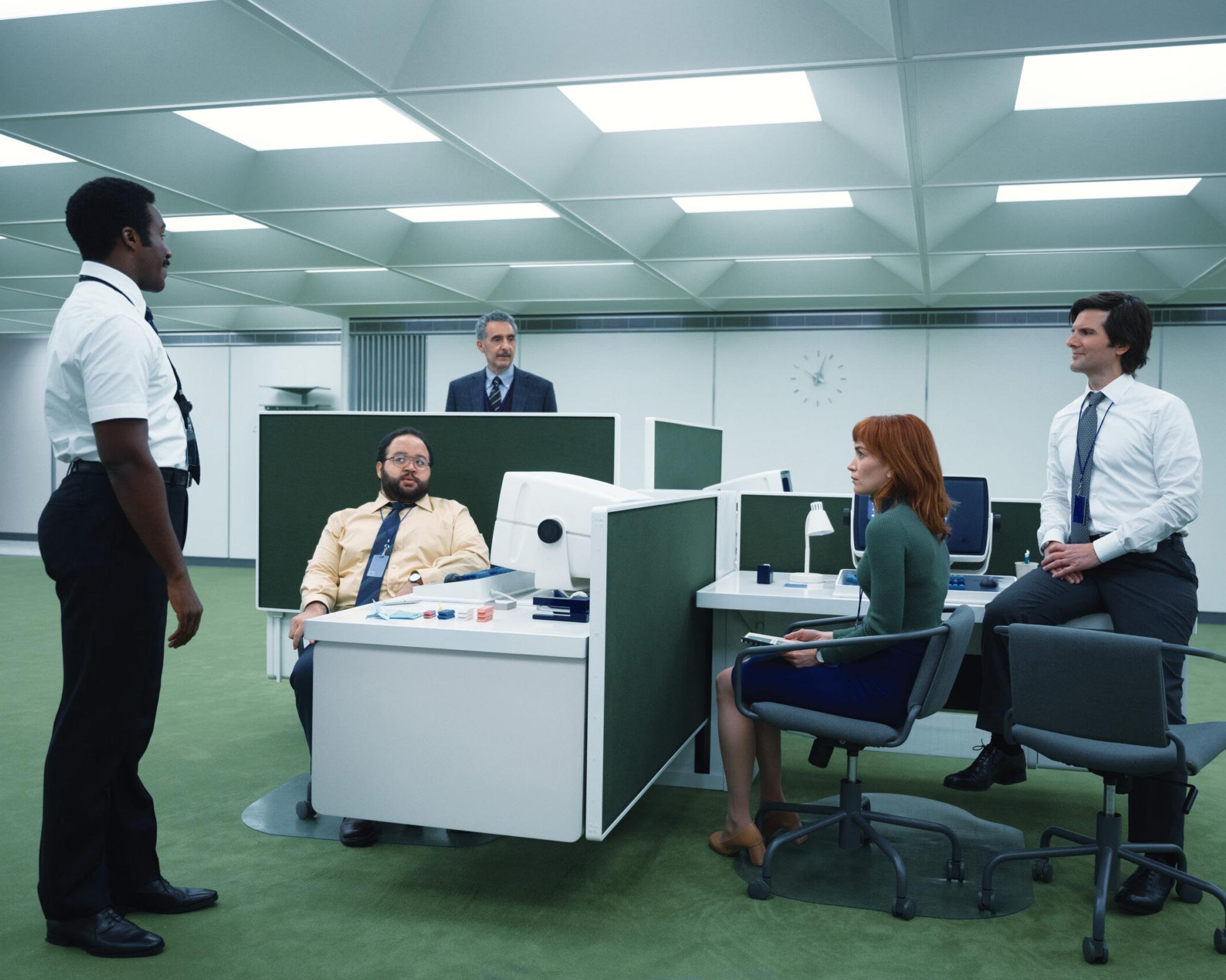
with the company that it’s always there, even if you can’t see it watching you, it’s probably watching you.”
The series includes a variety of visual aspects to convey this unsettling atmosphere. A mysterious goat-breeding sector of the Severed Floor mirrors the outlandishness of the concept. The Severed Floor refers to the workers who underwent the “severed” procedure – they all work on the same level. White-soaked rooms and hallways paint corporate as emotionless — “innies” are less than human. Robotic and stiff language is encouraged by workers, stripping them of personality. This concept in particular centers itself in Mr. Milchick, manager of the Severed Floor.
“I’m dying to know what’s going on with Milchick,” Hasselbach shared. “The racism he’s been treated with, having this black male character being told not to sound smart, not to use advanced language, I think it is wearing on him.”
The scene Hasselbach is referring to is when Milchick gets in trouble for
using sophisticated dialect when speaking to severed employees. Issues of racism are just one of the social issues that “Severance” attacks. A few others include child labor, familial relationships, religion, alienation and trauma.
USD students themselves are enraptured in the complexity of the new series. Rio Solis, a USD junior, shared his thoughts.
“My favorite part of ‘Severance’ is the way it makes you think about yourself, if you had to make a choice like that,” Solis said. “It puts you in a position that is more uncomfortable.”
With the dramatic conclusion of season two, fans are eager for more. Stiller announced that season three will hopefully be released in two to three years. Some Toreros may be impatient for season three, and may consider severing their memory until it’s released to save on time and anticipation. Until then, viewers will have plenty to chew on, with the show’s thought provoking social commentary keeping attention captivated until the day comes.
The main characters, or ‘innies,’ on the Severed Floor with their boss, Mr. Milchick.
Photo courtesy of @thespaceshipper/X
The show’s protagonist, Mark Scout, is played by Adam Scott.
Photo courtesy of @thespaceshipper/X
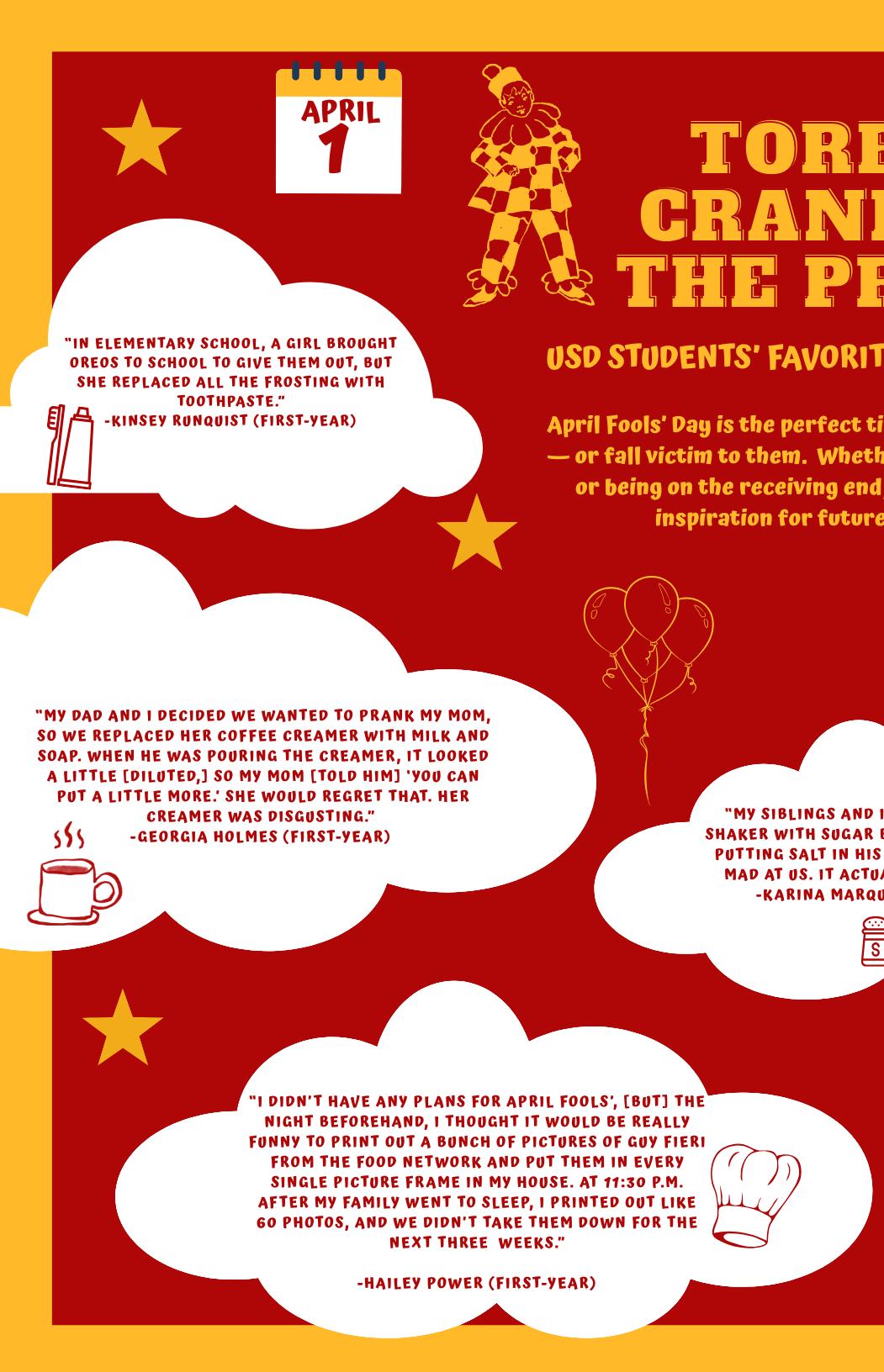
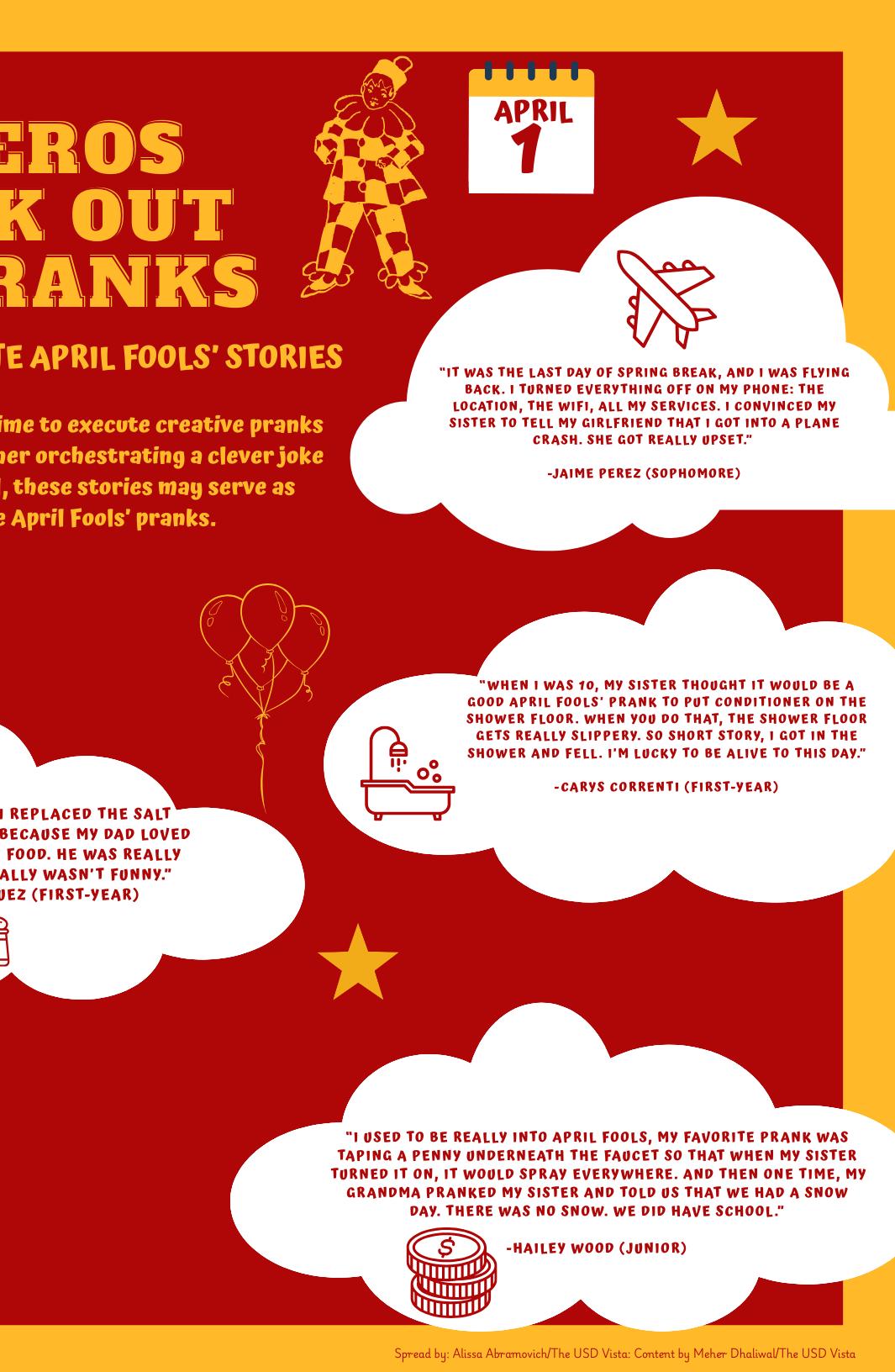
ARTS & FEATURE
A seat at the table in Tijuana
University Ministry students connect to community across
JOSHUA FEINGOLD CONTRIBUTOR
This past spring break, USD’s University Ministry (UM) sponsored a week-long education and service trip for students called “Tijuana Spring Breakthrough” in San Diego and Tijuana, Mexico.
I went along with them to explore Tijuana and gain experience working in communities across the border. University Minister Alec Hartman led the trip, along with USD seniors Giulio Fernandes and Emma Vigil. Hartman, who has led many trips to Tijuana with UM, explained the essence of these trips.
“Grounded in the Catholic Social Thought principles of human dignity, solidarity, the common good and the preferential option for the poor, this experience seeks to build relationships that transcend physical, cultural and societal barriers, uniting us through our shared humanity,” Hartman said.
For two nights, the group slept in the Our Lady of Guadalupe Church shelter in San Diego, which was previously migrant housing. The funding for the shelter had been shut off the week before due to sprawling federal cuts.
During this time, the students visited the San Diego Border Patrol Sector headquarters in Chula Vista and learned about the functions of border patrol and the Department of Homeland Security.
The group also visited the Otay Detention Center, a privatized detention facility which contributes profit to a billion dollar industry. After that, USD students attended a Mass at a makeshift church along the border where everyone joined together in a prayer service with the hopes that Friendship Park would reopen soon. Friendship Park was an initiative that created a shared space at the border where Mexicans and Americans could spend time together and connect. It first closed due to COVID-19 in 2020 and subsequently for the construction of a new border wall.
The following day, the group paid a visit to the Neighborhood Peace Church. USD alumni and MEChA member, Pedro Rios, Director of the U.S. Mexican Border Program of the American Friends Service Committee, talked to the group about the work he does. The organization helps people with legal documentation, offers attorney information, promotes allyship, works with the police and now provides “Know Your Rights” training with community members. They also provide water, food and medical care to migrants. The federal cuts affecting Our Lady Guadalupe Church also cut off funding for organizations like the one Rios works with.
“We’re on defensive mode because so many programs are being shut down,” Rios explained.
Rios has not been deterred and continues to assist the community through advocacy work.
“Join something that already exists and go to community groups,” he stated in reference to those who want to help people in need.
As the weekend in San Diego came to a close, the group set out for Tijuana. They made their home-base the Parroquia María Inmaculada, a Catholic church that serves communities in the eastern outskirts of Tijuana. It has welcomed USD students, faculty and staff for decades. The Parroquia is a center of community in a region affected very tangibly by poverty. Their work primarily serves the impoverished.
After their fill of welcome flautas, USD students took the opportunity to sit in on a roundtable meeting with the parish workers. These people all come together from different fields to satisfy the needs of their community; there were young men and women in medicine, law, divinity, industrial engineering, communications, psychology, music, education and social work.
The parish leader, Father Jesse, stated that their work is need-based.
the border
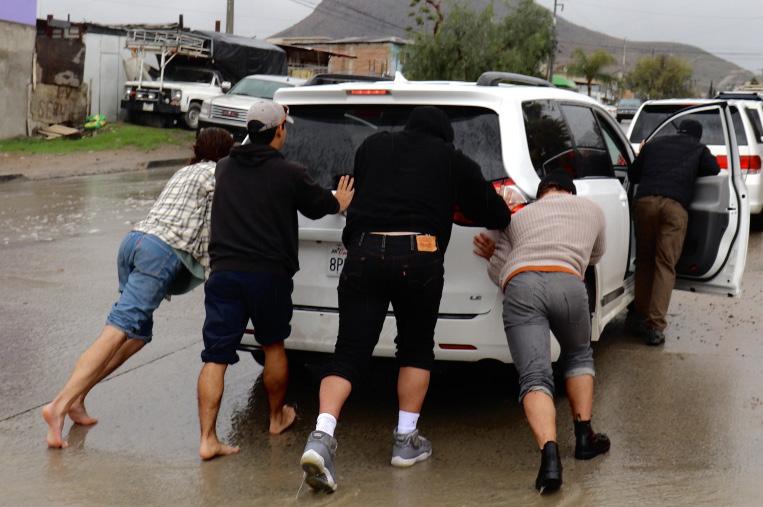
They interact directly with the community to determine the issues at hand and then address them. Rather than a top-down bureaucratic approach, the Parroquia utilizes a grassroots bottom-up strategy, which delivers services directly and efficiently.
The following day, the group visited a school for children with special needs. Because it was raining the day they visited, school was cancelled.
In certain areas of east Tijuana, the infrastructure is unprepared — rain can cause flooding and make it difficult for regular functions to occur.
On Wednesday, they visited Casa Del Migrante, a shelter for migrants, deportees and refugees.
The aim of Casa Del Migrante is to support families until they receive employment. Along with free room and board, people are offered job training, spiritual help, guidance, basic medical attention and human rights support. Legal advice and social services are
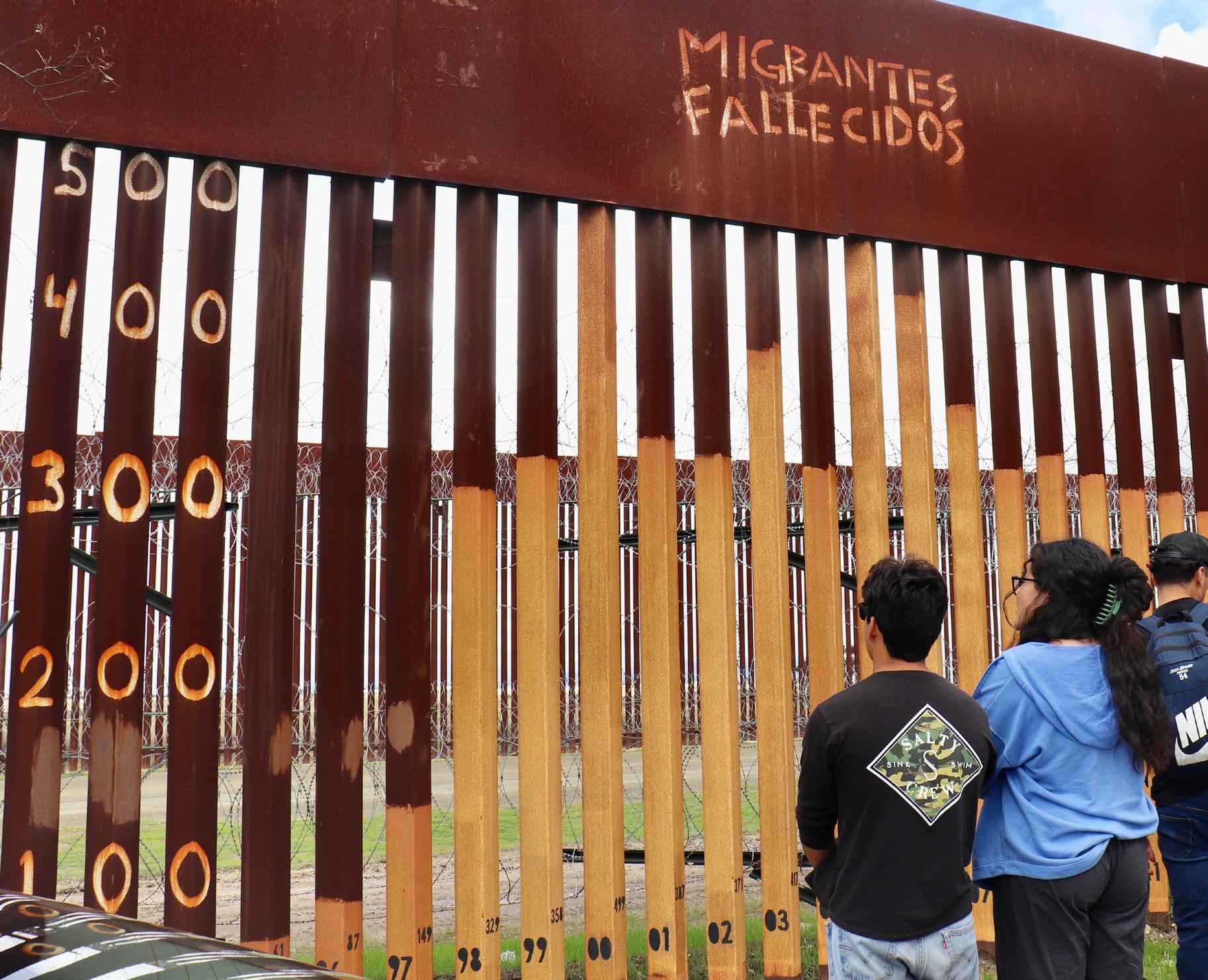
provided as well. A Mass was held and people from Guatemala, America, Nicaragua, Mexico and El Salvador gathered together in communion.
As students entered the building, a hallway opened up to three stories with a small area in the middle for communal activities. Colorful decorations lined the bannisters, leading to rooms on all sides. Everyone began playing games with the children that were there and laughter echoed to the ceiling.
USD first-year Maximiliano Acosta reflected on his time at Casa Migrantes.
“[A] great part was how a simple game of Loteria, despite most of the group not speaking Spanish, brought us all together in joy and happiness,” Acosta explained. “This showed me that no matter where you are from, or what language you can speak, you can always connect and create meaningful memories with one another. This trip brought me hope and taught me that anyone can make positive change in whatever community they are in.”
It was evident there was a disconnect between the elation of the children and the despair of their parents.
Tearful mothers took refuge in their sullen husband’s arms. This was their last resort. A pair of migrant brothers were discussing that after one more night, they were going to go back to living on the street. This was their reality.
Co-leader Fernandes was able to relate the trip to his own upbringing.
“The experience revealed the deep injustices and resilience woven into the borderlands,” Fernandes stated. “As a product of immigrant parents, these realities are something I’ve always been familiar with. Solidarity — rooted in presence, humility and mutual respect — is more powerful than charity could ever be.”
Later in the week, the group were guests of Albergue las Memorias, a medical facility assisting and caring for adults and minors living with HIV/ AIDS, tuberculosis and related diseases. The facility is run by the Las Memorias Shelter Civil Association, which provides these services to all residents for free. As the group was leaving, an ailing woman called out from her wheelchair in a dimly lit corridor.
“Don’t forget about us,” she said.
USD senior Julia Swenson-Wilkes responded as everyone trod out the door onto a rain soaked sidewalk.
“We won’t,” Swenson-Wilkes replied.
While returning to the parish from Albergue las Memorias, the group came across a flooded intersection. Cars were strewn about on the side of the road as a torrential downpour soaked a concerned owner of a disheveled vehicle, peering at the damage to their frame. Students eyed the flooding ominously, knowing that a treacherous impasse was approaching. The engine revved and the car plunged forward. Torrents of water gushing from the mountainside rose up over the bumper — going, going and nothing. The engine cut. It took only a few moments for everyone to look at each other, get out and push the van to safety.
Luckily, workers from a nearby hardware store raced to help and tried to jump the van to no avail. Hartman called the parish and had them tow it back and fixed it for no cost. Despite having no obligation to help out, the community was graciously offering their services.
In one of the two remaining vans, some of the students dropped off toys to a local orphanage.
That night, UM gathered to deliver care packages with basic necessities to those most in need around the community. They finished the evening with a community karaoke competition equipped with dancing, tamales and USD’s own Izzie Ramirez, a senior, taking home the prize as karaoke champion. Ramirez donated the prize back to the Parroquia.
“In these conversations, these stories, this vulnerability, we are called to action with a newfound understanding that all are welcome, and being able to experience that firsthand,” Ramirez reflected. “[It] put a fire in my heart for social justice rooted in humility and love for my neighbor.”
Tijuana Spring Breakthrough was a glimpse into the real impacts of injustice and the power of community. Students returned to campus with a deeper sense of responsibility and shared humanity.
In Tijuana, the engine of the University Ministry’s van gave out, and the community came together to fix it.
Photo courtesy of Joshua Feingold
Students visited the Mexico-U.S. Border on the UM Tijuana Spring Breakthrough trip.
Photo courtesy of Joshua Feingold
OPINION
Wash away the conflict
Sharing a kitchen in college can affect roommate relationships
ZOE ROGERS OPINION EDITOR
I’ve heard countless conversations — from both my friends and strangers throughout campus — about how annoyed they are with their roommates and the mess in the kitchen. While roommates can be a great addition to your living situation, the positives may not always outweigh the negatives. The presence of a kitchen has the ability to ruin your roommate experience.
Now is the time of year when people start looking for potential roommates for the next academic year. Having roommates has been one of my favorite parts of my college experience. Even now, I’m living in a space with my three closest friends, and I wouldn’t have it any other way. Having roommates comes with many luxuries, such as always having people to talk to, never feeling alone in the dorm or apartment and having someone to count on. But, living with roommates
can come with difficulties that can significantly impact your roommate relationship.
Everyone has different living habits. Some people don’t mind the room being a little cluttered or messy, while others need everything to be put away after it has been used. Because everyone has their own different personality and preferences around how to live their daily lives, conflict can arise between roommates — especially when one person feels like the other is not abiding by their living preferences.
It’s easy to be angry with your roommates when they don’t pick up after themselves or do the assigned tasks you had discussed at the beginning of the year. For example, my roommates and I discussed how we would go about taking out the trash, wiping the counter and more. When your roommates don’t follow through on those tasks as promised, feeling angry is an initial response many people take in this situation. Blame and resentment are
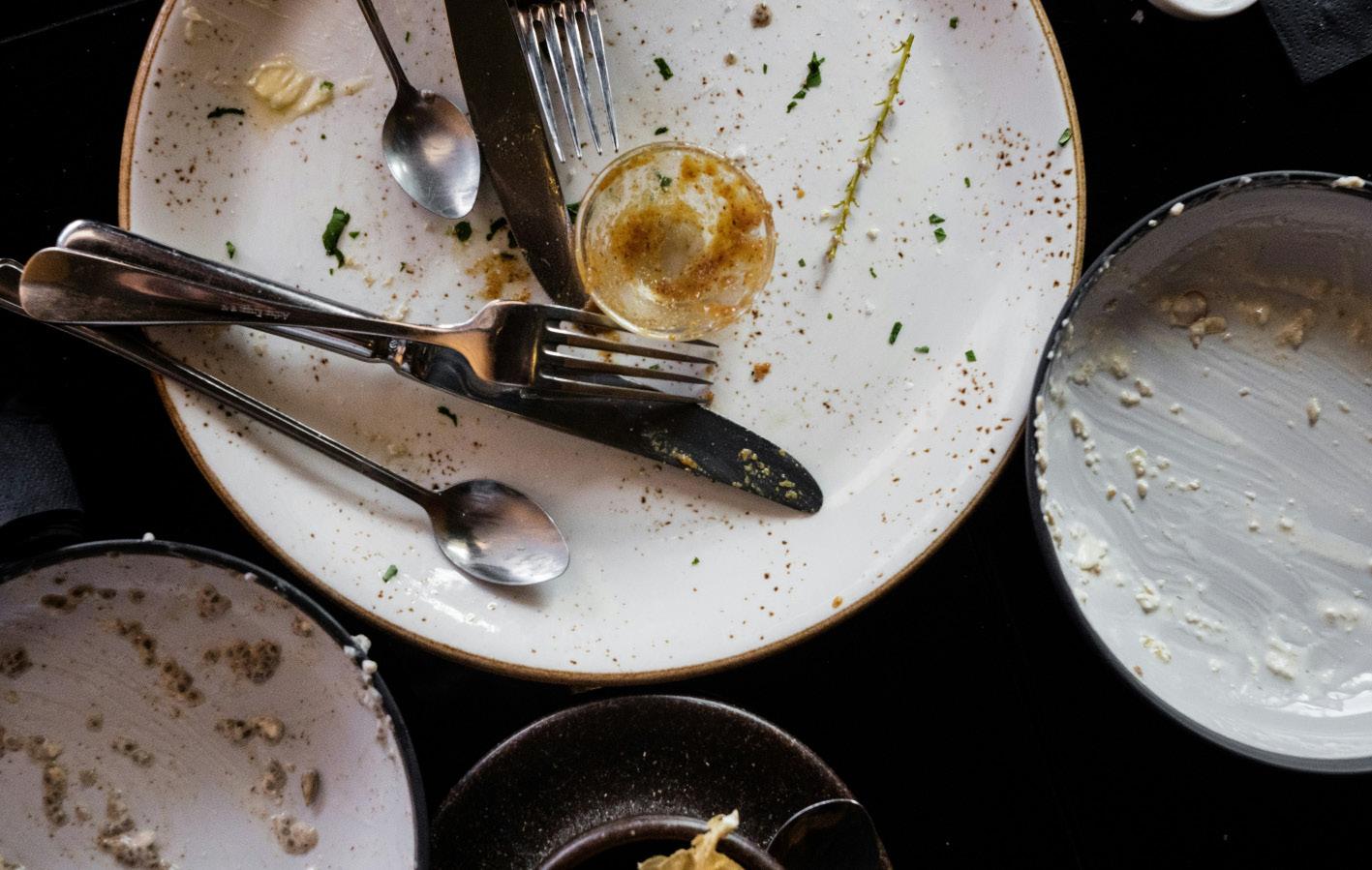
natural emotions when your once clean sink is now stacked with dirty dishes that are left for you to clean up. This whole issue can be avoided if you and your roomates just communicate about it. My roommates and I addressed that we had an issue
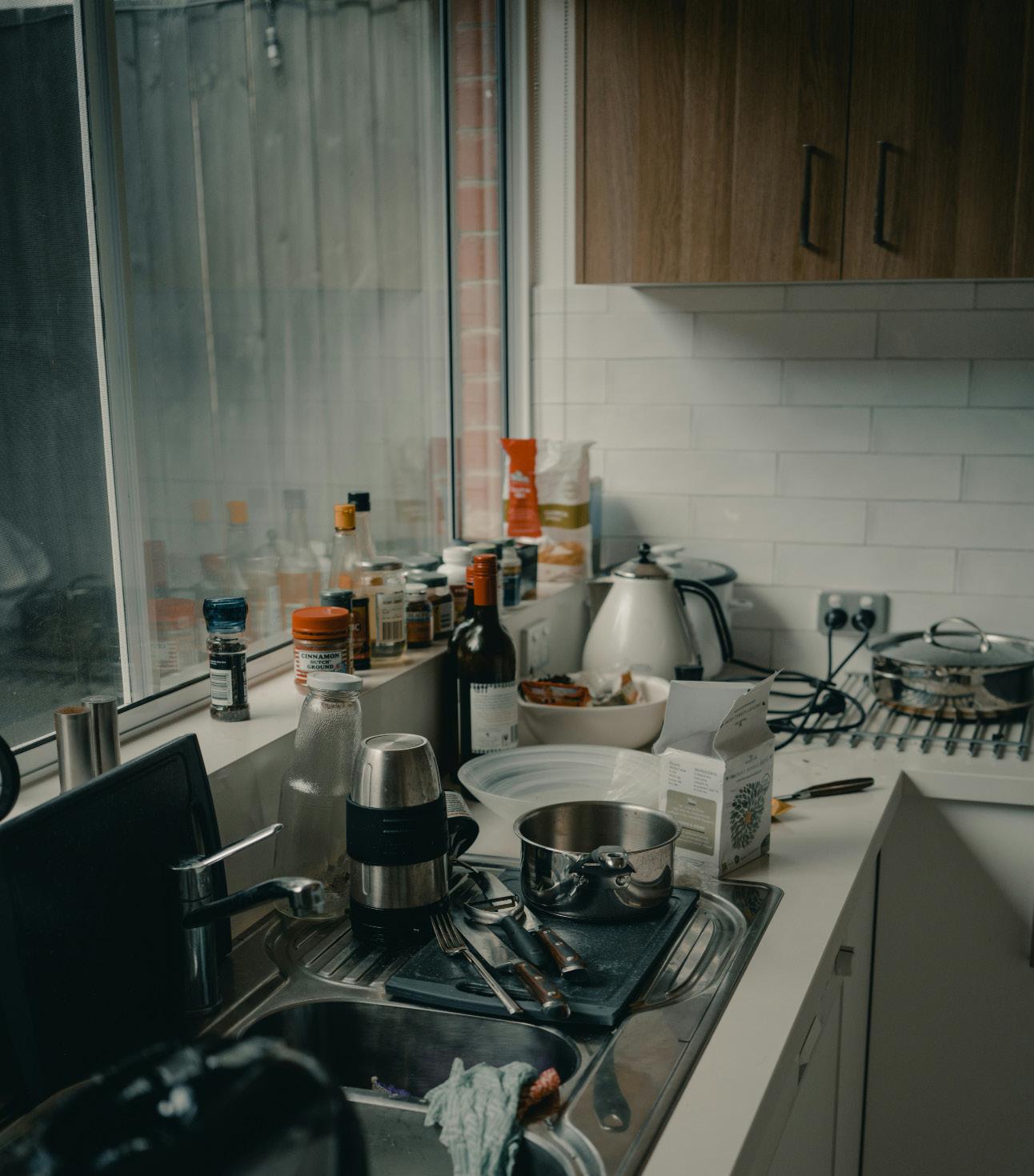
with taking out the trash — certain people would end up taking it out more than others, and it was becoming difficult to gauge who would be next to take on the responsibility. So, my roommate made a chart with our names on it. We have the chart hanging on the fridge, pinned up by a magnet on the name of the person whose job it is to take out the trash next. When that person does their duties, they move the magnet to the next person. This is just one example of techniques that you can use to deal with any uncertainty around whose job it is to do what, and when to do it.
While it’s easy to say that having a kitchen with your roommates has the potential to negatively impact you and your roommates’ relationships, it also has the chance to enhance impact it. Sharing a kitchen leads to spending more quality time with your roommates, allows you to do things together like cook or bake and gives you time to converse around the dining table together. Even though having a kitchen does require responsibilities, it doesn’t always have to be a bad thing. As long as roommates communicate effectively, then having a kitchen shouldn’t be a problem.
The kitchen can be a gamechanger in your living experience. Personally, I did not have a kitchen my first year of college. I was living in Founders and relied on microwavable meals and the occasional run to the shared kitchen to make scrambled eggs. Now, living in an on-campus apartment, I absolutely love having a kitchen in my vicinity.
Having a kitchen in a dorm or apartment makes the
chaos of deciding what to eat so much easier. I can make grocery runs, store the food in the fridge and make my own meals at my leisure. I find myself spending a lot of my time in the kitchen, whether it’s through making my own food or washing the dishes.
While having your own kitchen can be nice, sharing a kitchen with one to three other people can be a difficult challenge. LifeHack, a website that provides tips and tricks for different aspects of life, provided insight on the dynamics of having roommates and sharing a kitchen.
“Kitchens feed resentment and bitterness just as easily as they produce joy and, unless you and your roommates communicate directly, you’re in for a very bad time,” LifeHack stated.
Having a kitchen can be one of the best parts of your college experience. It allows you to have a sense of independence. However, incorporating a kitchen into your roommate experience can also instigate negative emotions toward one another, and even cost you your friendships.
Kitchens require responsibilities that many roommates may not agree upon. Issues like when to take out the trash, if leaving dirty dishes in the sink is okay or if it’s fine to leave a dirty pan on the stove when you’re running late can all cause a disconnect. If you and your roommates don’t communicate effectively about the different roles and responsibilities you have in regards to the kitchen, you and your roommates’ relationships can be at risk, and you may end up one dirty dish away from losing a friendship.
Having dirty dishes can cause conflict for many roommates.
Photo courtesy of @Portugues Gravity/Unsplash
OPINION
Alone, but not lonely
Spending time with yourself can be rejuvenating
JULIE FROMM ASST. OPINION EDITOR
While senior year for many — myself included — means job searching and assignmentavoiding, it also means soaking up as much time with your friends as you can. When my sister graduated from college and moved into an apartment alone, the thing she told me she missed the most about her college life was coming home from class to hangout on the couch with her roommates. I knew how precious this time was, and at the beginning of this semester, I prioritized spending time with my friends over everything. When I wasn’t sleeping or in class, I was at their houses.
As fun as that was, I started to feel emotionally drained by the end of the day. I realized I wasn’t spending enough time with myself, and I wasn’t taking care of myself the way that I should have been. The idea of not spending all of my time with my friends in my last few months of school felt terrible, but not having time to myself felt worse.
Now, I have found a healthy balance between spending time

with friends and spending time alone. It has taken me years to understand, but alone time is not a bad thing — it’s actually a great thing. Despite the pull toward hanging
out with my friends, I have always felt better when I prioritize alone time. As someone who leans more toward the introverted side, my social battery tends to run out

rapidly when I go out with friends. It’s not that I don’t love spending time with them, but having time to recharge and check in with myself is crucial to maintaining my happiness and well being.
Kendra Cherry, a writer who focuses on teaching students about psychology, explained this.
“When you have time for yourself, you get the chance to break free from social pressures and tap into your own thoughts, feelings, and experiences,” Cherry said.
Having dedicated time to yourself is a great way to step away from the stresses of your daily life and focus on what you really want and need.
From a young age, my mom told me that it was extremely important to be able to keep yourself entertained. This may have been because she didn’t always want to play with Barbies with me, but it has stuck with me and helped me throughout my adult life. Because I learned from a young age how to be happy in solitude, and that being alone and being lonely are different things, I don’t rely on other people for my happiness. I don’t feel anxious or experience fear of missing out when I spend a night in.
In fact, I prefer it sometimes, as it gives me the opportunity to do things that I often brush aside as unimportant, like being transfixed on a great book series or taking the extra few minutes to separate my laundry into lights and darks. These may seem like small things, but they bring me a great deal of peace and comfort.
During my first year of college, I hardly ever spent time alone. I was sharing a room with another person for the first time, and I couldn’t fathom eating anywhere on campus by myself. I could hardly walk to
class without being on the phone with someone or having music blasting through my headphones. Being in a new environment made me nervous and uncomfortable, and I relied on my friendships for stability and distraction. At the time, this worked out great, but as the years went by, I realized that I was pushing my own needs aside and wasn’t in touch with myself the way I was in high school. Now, as a senior in college, I live alone and am able to spend as much time with my friends as I want with the comfort of knowing that at the end of the day I get to go home and spend time with myself. I prioritize writing in my diary every day to get out any worries or frustrations. I go for walks in the morning and sometimes leave my headphones behind, as they can feel like a distraction from my thoughts. I take myself on “selfdates” by doing things like going to a coffee shop to get work done or window-shopping at the mall alone. My nervous, first-year self wouldn’t have been able to fathom this, but as I’ve grown up, being with myself has become my sanctuary.
As I gear up to leave college behind and start a full-time job, I am grateful that I have taken the time to get to know myself and relish my time alone. I am moving to a new city after graduation, and though that brings a new set of worries to my life, one thing I know for sure is that I am comfortable enough with myself to know that when I am alone, I’m not lonely. The idea of being states away from my closest friends and family can feel daunting, but because I have taken the time to feel comfortable in solitude, I don’t feel worried about exploring a new city by myself and facing challenges on my own.
Photo courtesy of @Alexandra Fuller/Unsplash
Even though being alone can feel uncomfortable, it can have its benefits.
Photo courtesy of @Bhavisu Thar/Unsplash
Robinson’s military history removed Department
LUKAS BLANKENSTEIN CONTRIBUTOR
On March 18, the Department of Defense (DoD) purged all articles relating to Diversity, Equity and Inclusion (DEI) from their website. This removal occurred in response to an executive order by President Donald Trump, ordering an end to all DEI programs across the federal government, including the DoD. Immediately after the purge, DoD spokesperson John Ullyot, citing Secretary of Defense Pete Hegseth, spoke of how pleased he was by the rapid removal of the articles.
“DEI is dead at the Defense Department,” Ullyot stated.
“It is a form of Woke cultural Marxism that Divides the Force, Erodes unit cohesion and Interferes with the services’ core warfighting mission.”
One of these removed articles was about the military history of Jackie Robinson. Robinson was the first ever African American baseball player to play in the MLB. He started at first base for the Brooklyn Dodgers on April 15, 1974, breaking the color barrier. This was prior to the team’s move to LA and before baseball was desegregated.
Over his illustrious career, Robinson was a six-time All Star, 1949 MVP and 1955 World Series champion, before retiring in 1956. His number, 42, was permanently retired in 1997 by the MLB, meaning no other player is allowed to wear 42 as their regular number. Robinson is the only player in MLB history to receive this honor.
Before breaking the color barrier, Robinson was a soldier during World War II. The article removed from the DoD website was part of a series of articles about sports stars who served in the military. The article detailed Robinson’s time with the army, including becoming a second lieutenant and serving
of Defense purges historic articles
with the “Black Panther” tank battalion. The article also detailed how Robinson was court-martialed for refusing to move to the back of a military bus, which Robinson was eventually acquitted for. When the article was removed, the URL redirected to one that read “DEI” in front of the words sports-heroes.
The removal of the article sparked widespread condemnation from the baseball world. On March 18, ESPN’s senior MLB insider, Jeff Passan, wrote a scathing condemnation of the DoD staff, referring to the people who removed Robinson’s article as “ghouls” and urging them to restore the article. The tweet was viewed 4.2 million times and received 38.7 thousand likes.
USD first-year Sophia Pinedo gave her reaction to the removal of the article.
“It’s sad to hear and disrespectful,” Pinedo said. “It’s not every day you hear about something like this, and it’s hard to understand.”
The article was one of many articles that caused controversy with its removal. In addition to Robinsons’ article, articles on the Navajo code talkers, corporal Ira Hayes and the Tuskegee airmen were all removed in the same manner as Robinsons’. The Navajo code talkers were a group of Navajo speakers who were used to code messages during WWII in a way that was essentially uncrackable by non-Navajo speakers. Corporal Ira Hayes was a Native American marine, and was one of six men pictured in the famous photo, “Raising the Flag at Iwo Jima.” The photo has since become used as a common symbol for the Marines, including being used as the inspiration for the U.S. Marine Corps War Memorial in Arlington, Virginia.
The Tuskegee airmen were an African American Air Force
for being ‘DEI’
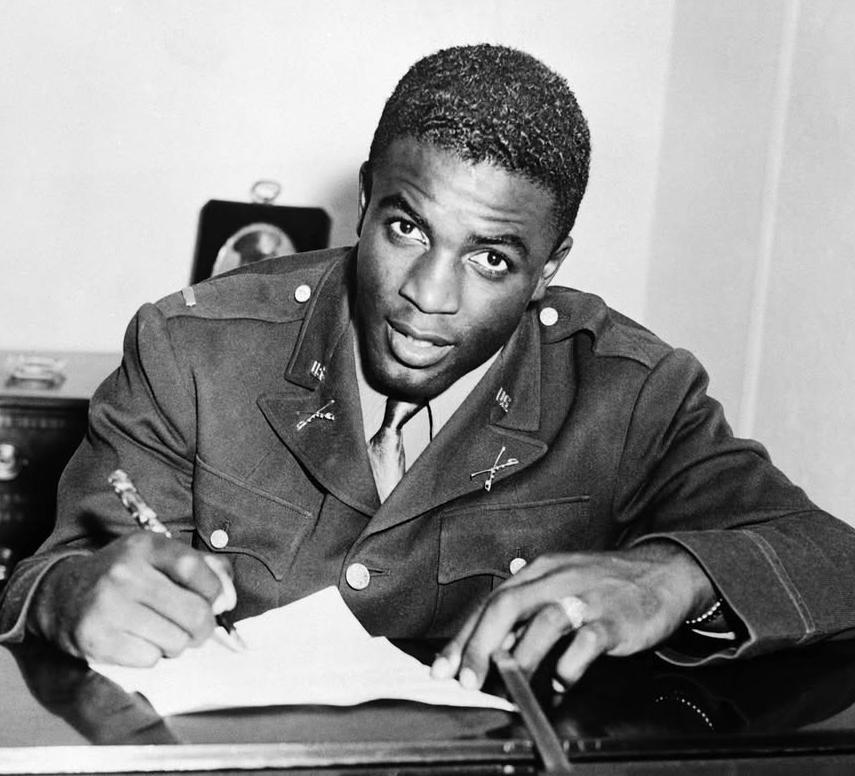
battalion that served during World War II. Colonel James H. Harvey III, one of the last remaining Tuskegee Airmen, spoke on the removal of the articles with the Associated Press, blaming Trump for worsening prejudices in America and accusing President Trump of racism.
“I thought there was progress in that area, but evidently there isn’t,” Harvey said. “I’ll tell it to [Trump’s] face. No problem. I’ll tell him, ‘You’re a racist,’ and see what he has to say about that.”
In response to the backlash, the DoD quickly apologized and claimed that the articles were removed by mistake. An hour and a half after proclaiming DEI to be dead, Ullyot released an apology, proclaiming his love
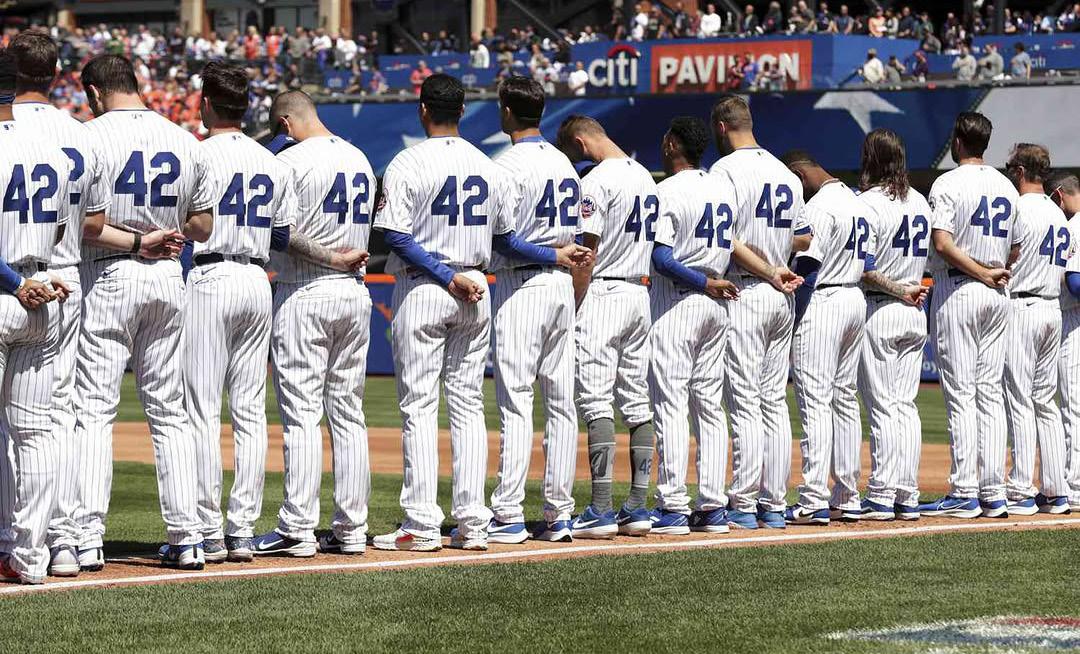
for those whose articles were stripped from the website.
“Everyone at the Defense Department loves Jackie Robinson, as well as the Navajo Code Talkers, the Tuskegee airmen, the Marines at Iwo Jima and so many others — we salute them for their strong, and in many cases heroic service to our country, full stop,” Ullyot said. “In the rare cases that content is removed — either deliberately or by mistake — that is out of the clearly outlined scope of the directive. We instruct the components and they correct the content so it recognizes our heroes for their dedicated service alongside their fellow Americans, period.”
The articles were all returned shortly thereafter. Ullyot was also removed from his role, taking up a new role in the DoD dealing with “special projects.”
The removal of the articles also coincides with Major League Baseball (MLB) quietly scaling back a number of their own diversity initiatives. In February, MLB commissioner Rob Manfred announced that their value of diversity was to remain unchanged. However, on March 21, three days after the Robinson debacle, the MLB removed all references and careers related to diversity from their career page. This included the MLB’s Diversity Pipeline Program, a program launched by the MLB in 2016 to help identify and develop management and administrative candidates from underrepresented backgrounds.
Manfred claimed that while they were still committed to diversity, they were currently evaluating their options to follow the law.
“Our values, particularly our values on diversity, remain unchanged, but another value that is pretty important to us is we always try to comply with what the law is,” Manfred said. “There seems to be an evolution going on here. We’re following that very carefully. Obviously, when things get a little more settled, we’ll examine each of our programs and make sure that while the values remain the same that we’re also consistent with what the law requires.”
On March 30, a new wrinkle was added to the story. It was reported that Jackie Robinson’s biography was flagged for removal from the Nimitz Library in the U.S. Naval Academy. This new batch of flagged books is in order to comply with a Trump executive order to end “racial indoctrination” in schools. The order flagged 900 books to be removed by the academy, including “The Autobiography of Martin Luther King Jr.” and “Einstein on Race and Racism.”
The story around Jackie Robinson’s military legacy is still developing. It does, however, raise questions on who else’s stories are being buried — who’s stories, as a result of these orders, are being stripped from websites and libraries. The removal of Robinson’s article and biography will continue to be debated as government policies proceed.
Jackie Robinson signing to join the LA Dodgers, becoming the first African American to play for an MLB team. Photo courtesy of @tonibarnhill808/Instagram
UCLA baseball team pictured honoring “Jackie Robinson Day” on April 15 by wearing his retired jersey, number 42. Photo courtesy of @jackierobinsonofficial/Instagram
SPORTS
Reggie Smith Softball Complex opens Ribbon cutting ceremony kicks off softball season
From Softball, Page 1
that the moment held special meaning not just for the current team, but for those who had been waiting years to see this vision come to life.
“This is something we’ve been wanting and hoping for since we’ve been here,” Knighten said.
Among the many players eager to step onto the new field, USD junior and catcher Natalie McCliman said the energy and expectations surrounding the season have completely shifted. With a new home base and the momentum of a fresh start, the team is more locked in than ever.
“It’s so gorgeous,” McCliman shared. “I’m really excited to be
able to start playing on it. We expect to dominate and hopefully end up winning [the] conference.”
For the first six weeks of the season, the Toreros played entirely on the road and practiced off-campus at Del Norte High School. The new facility gives the program a true home and a competitive advantage.
USD sophomore and right fielder Kaitlyn Wynia echoed McCliman’s sentiment, calling the new stadium a game-changer for the program. She shared how much the upgraded facility means to both the team and the fans.
“I love it,” Wynia said “I think it’s so great for the community and for us to be playing on it. If you build it,
more people will come. And to have bathrooms? I love it. It’s the little things that make a big difference.”
Wynia also shared that having a space that feels like home motivates the team to work even harder.
“It shows that people care about us and what we’re doing here,” Wynia added. “That support means everything.”
Cristina Byrne, a 2001 USD alumna and former starting outfielder for the Toreros, reflected on how the new stadium highlights the program’s remarkable growth.
“This is incredible,” Byrne proclaimed. “It’s come so far since I’ve been here. It’s neat to see the opportunities the girls
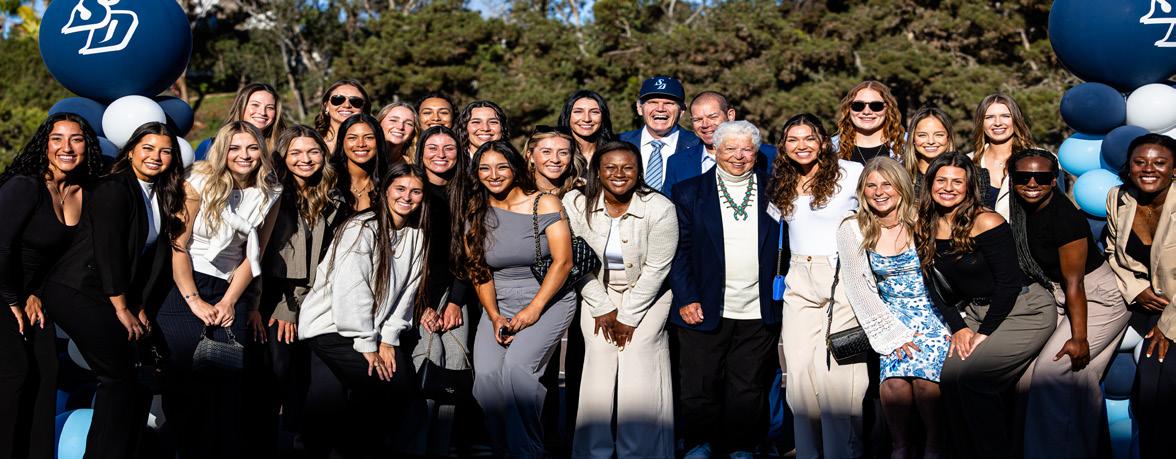
now get. We get to come home and see this beautiful venue.”
The Reggie Smith Softball Complex stands as a powerful symbol of the growth of women’s sports at USD and the lasting impact of meaningful investment.
The Toreros will officially debut their long-awaited
new home on April 5 with a doubleheader against the University of Santa Clara. More than just a game, the home opener marks the beginning of a new chapter — one built on legacy, recognition and a bold future for women’s athletics at the University of San Diego.
Alverson joins USD women’s basketball
USD parts with Cindy Fisher after 20 years
it takes to compete, lead and succeed on and off the court.”
Blanche Alverson, an experienced collegiate coach and former athlete, was recently hired as the fourth head coach in San Diego women’s basketball history.
USD Associate Vice President and Executive Director of Athletics Kimya Massey announced the coaching hire on March 25. After the announcement, there was a press conference held for questions regarding the new hire.
“The level of coaching talent attracted to the job was phenomenal,” Massey said at the press conference. “Blanche is a proven leader and mentor who has developed winning cultures at every stop of her career. As a former high level student-athlete herself, she understands what
The Toreros’ new head coach does not just have a talent for coaching; Alverson attended Auburn University and received her bachelor’s degree in biomedical sciences in 2013. During her time as an undergraduate, she played for the women’s basketball team at Auburn and set a slew of remarkable records. She finished her career ranked second all-time in three-pointers and became the fourth player in Auburn’s program history to record 1,000 points, 500 rebounds, 100 assists, 100 steals and 50 blocks.
During her graduating year, she was named to the Allstate Women’s Basketball Coaches Association (WBCA) Good Works Team, a program that recognizes college basketball players who
make outstanding contributions in community service. Her commitment on and off the court is something that the athletic board is looking forward to having.
“Her vision for USD women’s basketball reflects our shared commitment to raising the bar, returning to postseason play and building a program that consistently operates at a championship level,” Massey shared. “I’m looking forward to this next chapter and what lies ahead under her leadership.”
Alverson’s leadership so far has been largely successful. After receiving her master’s degree at Texas Tech University in sports management, Alverson began her coaching career as a graduate assistant at Texas Tech. She then held similar assistant coaching positions at New Mexico State
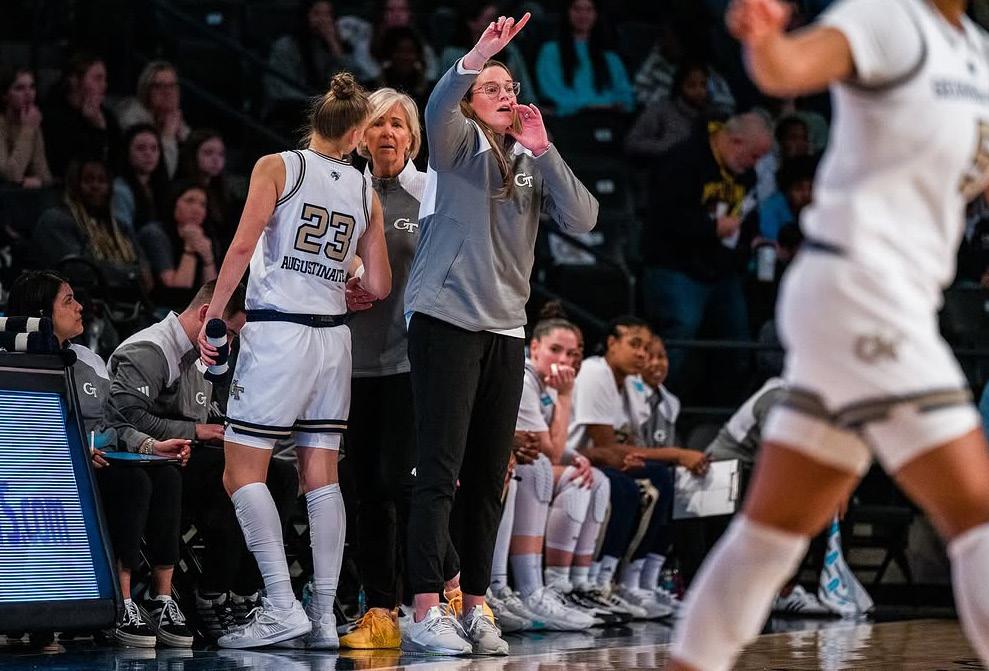
University, University of Southern California (USC) and the Georgia Institute of Technology. During her time at New Mexico State, she mentored two-time Western Athletic Conference (WAC) Player of the Year, Brooke Salas. At USC, Alverson secured the No. 5 recruiting class in the nation.
Most recently, she held the role of being Georgia Tech’s associate head coach. Under her leadership, the Yellow Jackets advanced to four post-season appearances.
The victories included three NCAA Tournaments, three 20+ win seasons, 12 victories over ranked opponents and the programs second-ever NCAA Sweet 16 run in March Madness. She coached the team into climbing to No. 13 in the Associated Press poll for the longest win streak with 15 games.
Alverson also led multiple academic initiatives, with many student-athletes receiving conference academic awards under her leadership.
Many Torero leaders are excited about her addition to the staff, including head USD men’s basketball coach, Josh Pastner.
“From the start, I’ve been very impressed and inspired by the leadership, the mission and the shared vision for what Torero women’s basketball can become,” Alverson explained. “USD is a special place — elite academics, a beautiful campus, top-tier facilities and a community that truly cares. I’m honored to lead and serve the incredible young women in this program, and I’m excited to build something meaningful — on and off the court. I believe we can recruit and compete at a championship level, both within the conference and nationally.”
Prior to March 25, Cindy Fisher was the head coach of the USD women’s basketball team. She began her leadership of the Toreros in 2005, and managed to succeed in nine postseason appearances. Fisher’s guidance earned her three West Coast Conference Coach of the Year honors, occurring in 2007, 2012 and 2020. She ended her time as a Torero with an overall record of 345 - 267. Fisher recently parted ways with USD after 20 years. The USD Vista reached out to Fisher, assistant coaches and athletes to learn about her step back on multiple occasions, and all failed or declined to comment. Looking forward, the USD community seems optimistic about Alverson’s fresh perspective on the women’s basketball team. With the 2025 season coming to a close with an overall record of 7 - 24, the Toreros will see how Alverson fairs in 2026.
“Blanche Alverson is a slam dunk hire,” Pastner said. “She’s a relentless competitor, a phenomenal leader, and one of the most driven and dynamic coaches in the country. Her energy is infectious, her connection with players is unmatched, and she’s going to do amazing things at USD. I’m fired up for her and for the future of Torero Women’s Basketball!” Alverson herself is excited for the new adventure.
The women’s softball team and President Harris at the ribbon cutting ceremony.
Photos by Tom Christensen
Blanche Alverson coaching the Georgia Tech women’s team.
Photo courtesy of @blanchealverson/Instagram
RILEY RAINS SPORTS EDITOR
